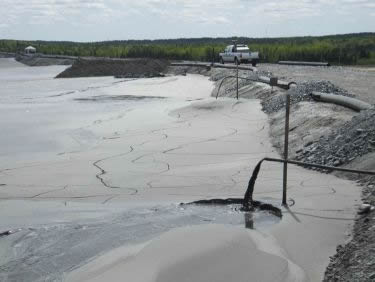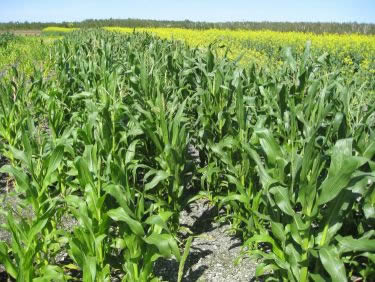Tailings Management at NRCan

Tailings impoundment in mountainous terrain at the Bralorne Gold Mine in British Columbia
PDF (382 kb)
Overview
- Tailings are the byproducts that remain following the extraction and recovery of valuable minerals from mine operations. They are generated by a milling process and are a mixture of finely-ground sand-to silt-sized rock particles, water, and processing reagents.
- Tailings Management is a fundamental component in the design and operation of mining projects in Canada. Potential environmental and socio-economic considerations need to be balanced to ensure disposal and storage of tailings occurs in a sustainable and responsible manner.
- Natural Resources Canada (NRCan) has a mandate to promote the sustainable development and responsible use of Canada’s mineral, energy and forestry resources, and to develop an understanding of Canada’s land mass. In fulfilling this mandate, the department plays a key role in promoting ways to better understand and mitigate the environmental impacts of mine tailings through the provision of scientific research and policy advice.
Tailings Management
- The objective of tailings management is to confine the mine tailings and provide for their safe, long-term disposal. Tailings are stored in engineered structures called tailings impoundment areas, which can be created through the use of dams, berms, and natural features of the mine site such as valleys, hillsides, or depressions.
- Responsible tailings management needs to consider the specific characteristics of tailings. For example, mine operators must take into account the presence of sulphide minerals in base and precious metal mine tailings, while oil sands tailings operators have to manage mineral solids that are extremely fine and do not readily separate from the water contained in the tailings.
- Based on the site-specific conditions and the type of tailings, there are two primary methods of long-term management, using either wet or dry covers:
- Wet covers require site-specific conditions that allow the tailings to be continuously submerged by water.
- Dry covers employ the use of a solid material such as soil or a membrane to physically separate the tailings from the environment.
- Due to the variability of local conditions, mine operators can employ a number of additional tailings management strategies that include: thickened tailings (mechanical dewatering of tailings) which is often used for oil sands tailings, backfilling of tailings underground, desulphurization of tailings (reduction of their acid-generating capability), or the co-disposal of tailings and waste rock (minimize pore spacing and reaction of tailings).
- No one solution exists for the secure management of all forms of tailings given that tailings facilities must be designed for site-specific environmental conditions, ore type, geochemistry, topography and other constraints. However, all tailings management options are designed to minimize interactions between the tailings and the local environment to prevent acid generation, metal leaching and contamination of surface water and groundwater. Robust tailings management can mitigate deleterious effects on vegetation, wildlife and aquatic life and possible human health impacts.
Environmental Protection
- Tailings management facilities for natural resource projects, such as mines or oil sands operations in Canada, are subject to policy, legislative and regulatory mechanisms designed to ensure the protection of the environment and the health of Canadians. Federal, provincial and territorial governments all share environmental protection responsibilities related to tailings management.
- Tailings management facilities are often a key element in the rigorous environmental assessment and regulatory processes that federal, provincial and territorial governments employ to ensure that the environmental effects of proposed mine projects are identified and that the significance of those effects are considered in project design prior to regulatory approval.
- At the federal level, the Government of Canada may be responsible for regulatory decisions specific to tailings management if they involve uranium tailings (Canadian Nuclear Safety Commission), navigable waters (Transport Canada), fish bearing waters and fisheries (Fisheries and Oceans Canada and Environment Canada), environmental matters of international and inter-provincial concern (Environment Canada) and federal lands.
- NRCan does not have a mandate with respect to the regulation of tailings but plays an important scientific role by providing expertise and specialist information in environmental assessment and regulatory processes related to:
- tailings management;
- acidic drainage and metal leaching;
- effluent treatment;
- water management;
- surface and groundwater resources;
- engineering geology;
- effects of climate change and seismicity;
- glaciology;
- mine waste reduction and re-use; and,
- forest ecosystem and forest community impacts and land/vegetation reclamation.
Research and Development
- In addition to providing science-policy advice, NRCan conducts a broad range of research that pertains to the management of tailings. The department is working with provincial and territorial governments, industry and academia to assess and develop new waste management options.
- Improved tailings management approaches can lead to improved environmental outcomes and substantial competitive advantages for Canadian natural resource sectors by reducing overall costs for tailings management systems, decreasing the footprint of tailings facilities, preventing or mitigating risks to the environment and human health and minimizing the time required for long-term monitoring and maintenance.

LaRonde Tailings Impoundment area (Agnico Eagle Mines Ltd.) Showing deposit fo tailings through spigots
- The Lands and Minerals Sector – CanmetMINING under the Green Mining Initiative is exploring waste management options by focusing research activities on the reduction of waste volume, reduction and stabilization of contaminants in wastes, use of wastes as a resource, underground waste storage, improved design for engineered covers, assessment of climate change impacts on tailings management practices and the acceleration of rehabilitation and reuse of land. CanmetMINING is very active in tailings management science and technology. Two of its flagship projects are the Mine Environment Neutral Drainage (MEND) program and the Green Mines Green Energy (GMGE) initiative. The MEND program has developed science-based technologies to enable the operation and closure of acid-generating tailings disposal areas in a predictable, affordable, timely and environmentally acceptable manner. Through this multi-stakeholder initiative, Canadian mining companies and the federal and provincial governments have reduced the liability due to acidic drainage by an estimated $360 million (1996 $). GMGE is a CanmetMINING led consortium to examine use of “waste” organic materials to rehabilitate mine sites and establish energy crops for the production of biofuels.
- The CanmetENERGY Laboratory-Devon conducts research and development that focuses on mitigating the environmental impact of surface-mined oil sands development. The reduction of fluid tailings inventory and bitumen in tailings ponds and tailings pond reclamation strategies are major activities. For example, the research and technology development program at NRCan-Devon on dry stackable tailings has played a significant role in the industry move to commercialize several oil sands tailings technologies, including thin-lift dewatering, rim-ditching, and centrifugation.
- The Earth Sciences Sector (Geological Survey of Canada and Canada Centre for Remote Sensing) (ESS) leads ongoing studies of the environmental impacts associated with metal and non-metal tailings under the Environmental Geoscience and Remote Sensing Science programs. Current research activities include optimizing remediation methods for historical gold mine tailings to protect ecosystem and human health, developing geo-environmental models in collaboration with CanmetMINING to better predict and monitor the environmental effects associated with the future development of gold, uranium and rare earth element deposits and establishing the natural background of inorganic and organic constituents in the environment surrounding oil sands deposits to inform decision making. ESS is also working with federal and provincial government departments and universities to apply remote sensing to improve monitoring and regulatory system performance in the Alberta Oil Sands.
- The Canadian Forest Service (CFS) draws upon its own historical knowledge and ongoing research, and that of others, when providing advice on the structure, function and dynamics of forest ecosystems in support of Federal policy. CFS’ knowledge and expertise contributes to the understanding of how forest ecosystems function and react to disturbances. CFS partners with other NRCan sectors and stakeholders in support of responsible resource development including the reclamation of forests. CFS’ expertise contributes to Federal environmental risk assessment, and positions NRCan to contribute to Federal priorities.
The Future of Tailings Management

Biosolids from a paper mill spread over a mine tailings site in Sudbury, Ontario where corn and canola were planted to make renewable biofuels
- NRCan has an opportunity to influence the science and technology employed by the mining industry to manage tailings at existing and future mine sites. For example, the Green Mining Initiative (GMI) is an innovative multi-stakeholder initiative under the collaborative leadership of NRCan. The GMI will develop superior technologies and practices so that mining will leave behind only clean water, rehabilitated landscapes and healthy ecosystems, while doing so with reduced energy consumption.
- A Compendium of Tailings Management Science and Research Initiatives at Natural Resources Canada [PDF 988 kb], (February 2013) has been developed by NRCan for the purpose of sharing scientific knowledge in tailings management and promoting partnerships in tailings research. This collection of research initiatives demonstrates Natural Resources Canada’s ongoing commitment to improving tailings management in Canada.
Page details
- Date modified: